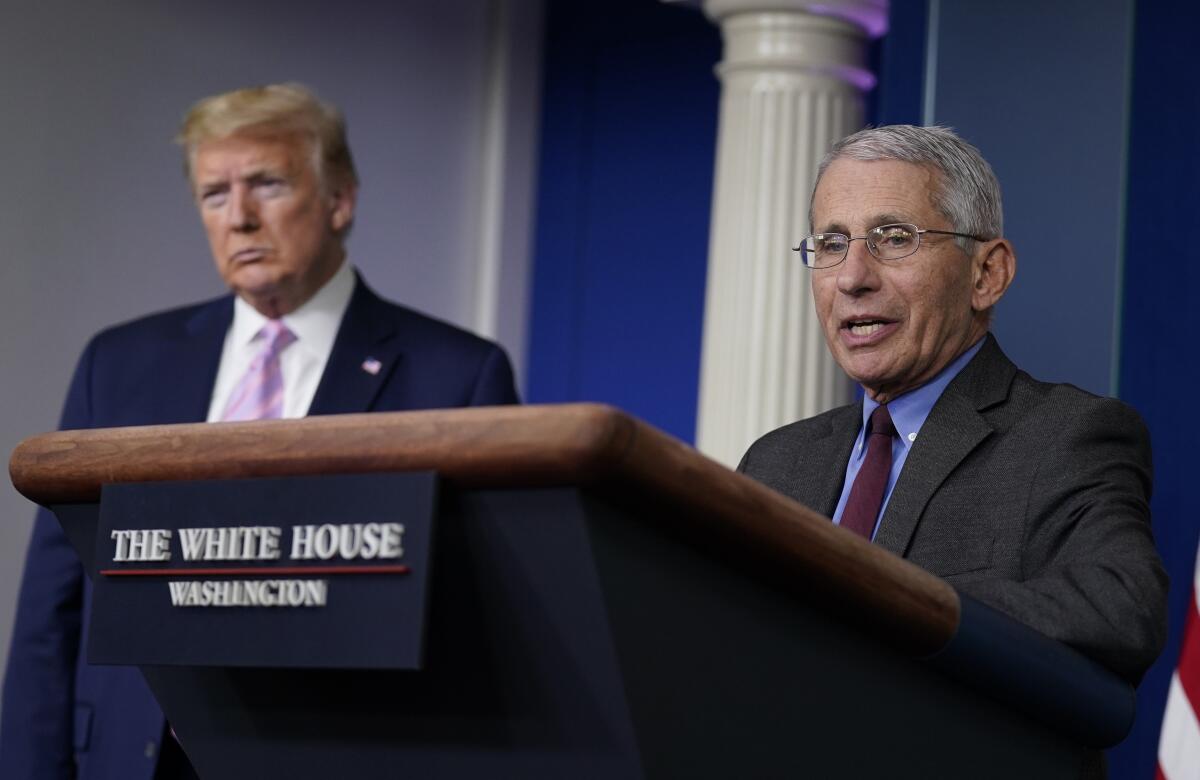No, Mr. Trump, you don’t get to decide when the economy restarts

- Share via
Columnist Holman Jenkins offered an analogy in the Wall Street Journal over the weekend that captures the conundrum created by the U.S. response to COVID-19.
“Imagine a problem that can be solved by holding your head underwater,” Jenkins wrote, “but stops being solved when you lift your head out.” In other words, the stay-at-home measures adopted to protect against the outbreak are damaging in their own right, and not a cure for the disease.
In fact, there is no known cure, just a number of drug therapies being tested and vaccines in development. That’s why it’s so disturbing to hear President Trump assert, as he did again Monday, that he has the power to “open up the states,” presumably by lifting the restrictions on movement and commerce.
“When somebody’s the president of the United States, the authority is total,” Trump said at Monday’s coronavirus briefing. “It’s total. And the governors know that.”
Oh please. Trump has a lot of influence over the country’s response to COVID-19, for better and worse. But thankfully, one thing he cannot do is order states to change the restrictions they’ve put on the public to safeguard health and safety — a core function of state and local governments.
As UC Berkeley School of Law Dean Erwin Chemerinsky explained in The Times last month, “no federal law gives the president power to order businesses to close or, for that matter, to open.” Nor is this Congress going to give this president that power.
He was a very sick man when he arrived in our emergency room, but he was more worried about the hospital staff than about himself.
There’s no question that the coronavirus-fighting measures have flattened the economy as they’ve flattened the curve of COVID-19. The restrictions have taken a huge toll on businesses and their workers, especially at retailers, services and manufacturers whose employees can’t do their jobs from home. Unemployment has climbed at unimaginable speed, and as workers have lost income, the pain has spread across the economy in the form of shrinking sales, unpaid bills and canceled outings.
Some critics of the social distancing measures are pushing Trump to act because they believe the damage being inflicted to the economy is greater than the potential harm from the coronavirus — an argument that has only gained steam as the restrictions have slowed the disease’s march. Meanwhile, Trump has his own political motives for wanting to get the country’s commercial engine up and running again: It’s tough for a president to win reelection in the midst of a recession.
Yet the hard medical reality is that we can’t keep the virus from exploding again until we know who has it, where they have been, whom they come into contact with and who has become immune — and only then if we have an adequate supply of an effective treatment for the disease it causes.
That means being able to test for COVID-19 at a scale we’re not even approaching today. That means having a widespread ability to screen people regularly for the antibodies that demonstrate immunity. That means having technologies and protocols to identify, notify, quarantine and test all the people who’ve recently come into contact with each person newly diagnosed with COVID-19.
A much more realistic announcement about the path back to normalcy was the one Monday by the governors of California, Oregon and Washington, three early adopters of tough social distancing rules that have dramatically slowed the spread of COVID-19. The governors said they would work together to develop “a shared approach for reopening our economies — one that identifies clear indicators for communities to restart public life and business.”
It’s more a statement of principles than a blueprint for action at the moment, but the priorities laid out are the right ones. Pledging to be guided by “health outcomes and science,” they articulated four goals: developing their own system for “testing, tracking and isolating” the disease (a step this editorial board advocated last week); protecting vulnerable populations, such as nursing home residents; ensuring an adequate supply of hospital beds and protective equipment; and mitigating the disease’s indirect effects on people who need other forms of medical care.
The states’ effort offers a sharp contrast with Fox News’ report that Trump plans to put his chief of staff, two economic advisers, most of his cabinet secretaries and two family members on a new council to help him decide when to lift the health-related restrictions. If any actual medical experts are included, they’ll be badly outnumbered.
Inevitably, moving back toward life before the coronavirus will require decisions about how much risk to take and who will be most exposed to it. That’s a political decision, not a medical one, even if it is informed by medical experts (as it should be). And it’s a decision best made by officials closest to the people whose lives and livelihoods are at risk, not one man in the Oval Office.
More to Read
Updates
5:01 p.m. April 13, 2020: This editorial was updated with more reporting on developments from the White House Monday.
A cure for the common opinion
Get thought-provoking perspectives with our weekly newsletter.
You may occasionally receive promotional content from the Los Angeles Times.









